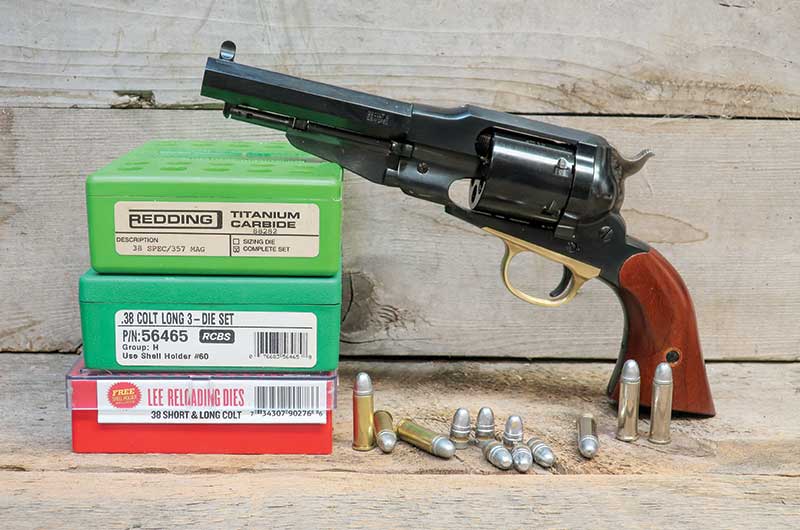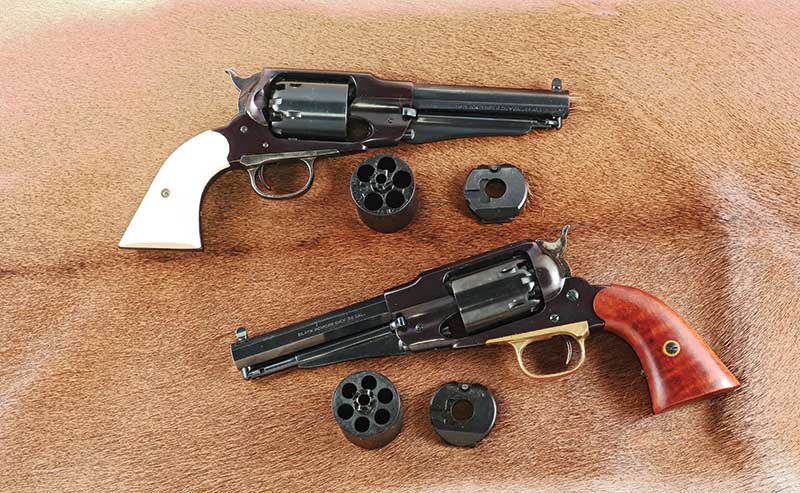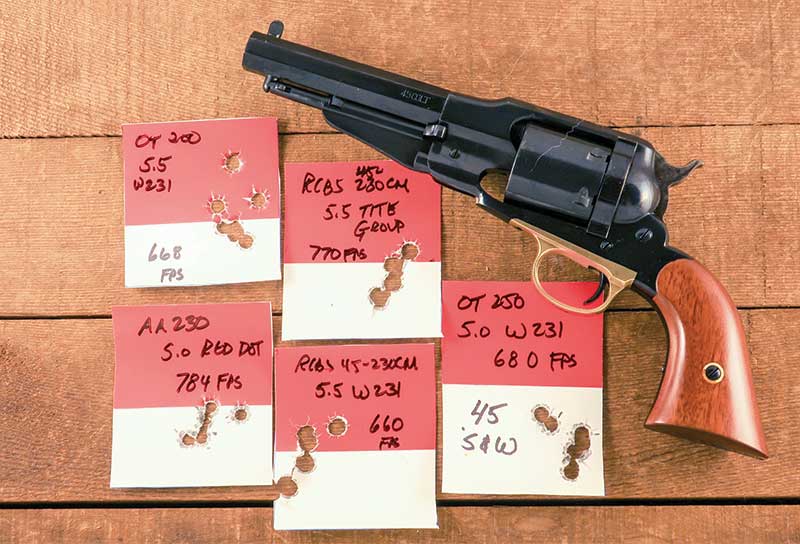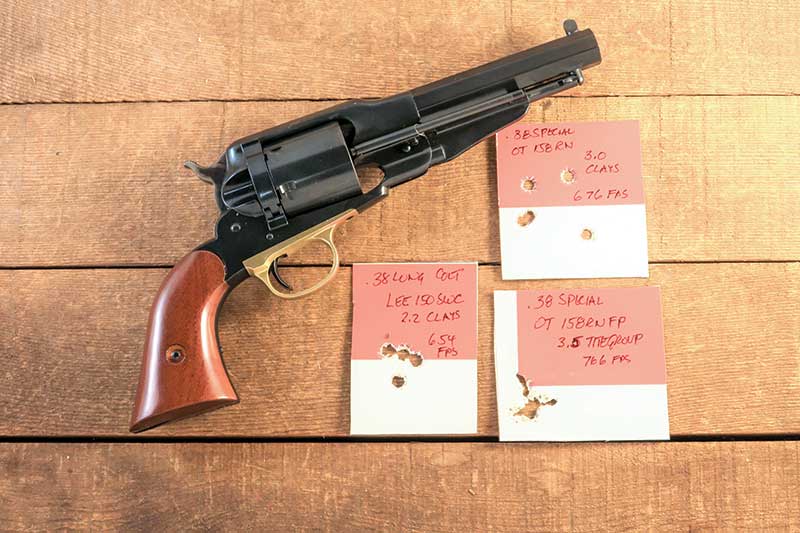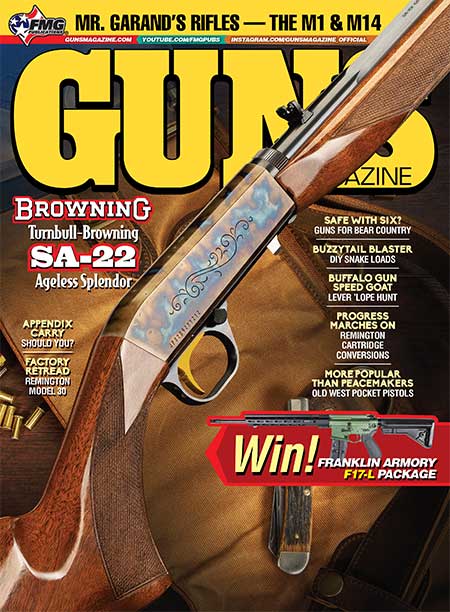Remington Sixguns Part II:
The Cartridge Conversions
In 1856, Smith & Wesson entered into an agreement with Rollin White who held the patent on revolvers with bored-through cylinders. Then in 1857, S&W introduced the Model #1 as the first cartridge-firing revolver. Sam Colt could have had the Rollin White patent ahead of Smith & Wesson but felt powder, cap and ball would always be preferred.
Patent Problem
Due to the White patent, no one else except Smith & Wesson would be allowed to produce cartridge firing revolvers until 1869. In 1868, Smith & Wesson entered an agreement with Remington allowing them (Remington) to convert their percussion pistols to cartridge firing revolvers using a bored-through cylinder. For this privilege, Remington had to pay Smith & Wesson $1 per pistol — a large sum in those days. The Civil War had ended in 1865 and both Colt and Remington found themselves with a large surplus of percussion pistols that could be converted to cartridge-firing sixguns.
In 1866, Remington began to convert both their .44 Army and .36 Navy percussion pistols to accept cartridges. To do this, an auxiliary cylinder replaced the percussion cylinder and accepted cartridges. Two years later, Remington made a deal with Smith & Wesson to allow them to manufacture Remington models with a cartridge-firing cylinder. Actually, Remington was not this forward-looking — a Cincinnati arms dealer by the name of Benjamin Kittredge ordered 4,575 cartridge-firing Remington revolvers and paid the $1 per gun royalty to Smith & Wesson.
A recoil plate was attached to the recoil shield of the Remington frame with a small screw. The idea of a loading gate had not yet appeared so the Remington recoil shield and frame were cut away to allow cartridges to be loaded and removed. Also, there was no ejector rod so the next step was to add an ejector rod and housing on the right side of the barrel. The ejector rod itself was held in place by a slot in the loading lever; this was the only purpose the loading lever (left over from percussion revolvers) actually served.
By the paying of this dollar per sixgun to Smith & Wesson, Remington had a three-year start on Colt when it came to providing cartridge-firing revolvers. Smith & Wesson tried to further prevent Colt from doing so by applying for a patent extension. The government had not been too pleased with Smith & Wesson for preventing other companies from producing cartridge-firing revolvers. Congress tried to grant an extension petition. However, the president, former Union Gen. Ulysses Grant, vetoed the whole idea. Smith & Wesson did succeed in delaying Colt from producing a cartridge-firing revolver until 1871. Colt did convert their 1860 Army using the Richards and Richards-Mason Conversions. However, they were not able to produce their first dedicated cartridge-firing sixgun until the 1871-72 Open Top
Conversion Today
Today Remington percussion pistols can be made easily into cartridge conversions by simply adding conversion cylinders. First, I had Milt Morrison of Qualite Pistol and Revolver start with a pair of 1858 Remingtons, one in .44 and the other a .36 cap and ball, and shorten the barrels to 5 ½”. Once this was finished, it was only necessary to add conversion cylinders. For the former, one has two choices as I have excellent-quality Kirst Konverter Cartridge Conversion Cylinders in both .45 Colt and .45 ACP while in the latter Remington, the same cylinder will work with both .38 Special and .38 Long Colt. If one is a reloader, very-easy-shooting loads for practice can be made up using .38 Short Colt brass.
There is something that needs to be noted about .38 Conversions — there is no problem with the Richards, Richards-Mason, or 1871-72 Open-Top. However, if a cartridge cylinder is added to a Remington or Colt .36, there will be a problem when trying to fire standard loads. Both have 0.375″ barrels instead of the normal .38 barrel of 0.357″. The original .38 Colt loads used a heeled bullet smaller at the base to fit into the brass case, while the remainder of the bullet was the same diameter as the brass to mate up with a barrel. To obtain any accuracy with conventional bullets in modern brass, one needs soft-cast hollow-base bullets, which will expand to fit the rifling of the larger barrels. Hollow-base wadcutters will work or Buffalo Arms offers soft-cast bullets with hollow bases.
Most of these conversion cylinders come with a back plate with six firing pins, safety notches between chambers and a locating pin in the back of the cylinder that mates up with a corresponding hole in the conversion ring/back plate. To load, the back plate is removed, cartridges are placed in the cylinder, the back plate is replaced, the cylinder is carefully placed back in the frame then the base pin is returned. To unload, it is necessary to remove the cylinder, take off the back plate and remove the cartridges. If they do not fall out by gravity, it is handy to have some kind of a rod or a wooden dowel to tap them out from the front of the cylinder.
In this day and age with semi-automatic pistols holding 18 or more cartridges, I still find these replicas of 150+-year-old sixguns have a place in my sixgunnin’ life. I’ve spent much of my shooting life testing and using the most powerful sixguns ever produced. However, at this stage of my life I find these easy-shooting Cartridge Conversions to be quite welcome.
For concealed carry, they may not be anywhere near the upper part of the list of practical options. However, they will still certainly work and especially for traveling off the beaten path be it in sagebrush, foothills, forests, or mountain, they will still work just fine while giving us a grand connection to the past.
